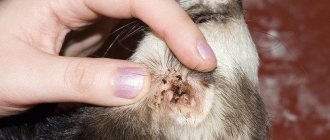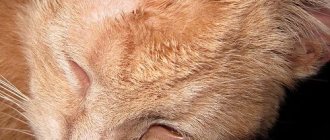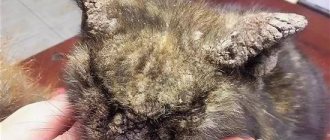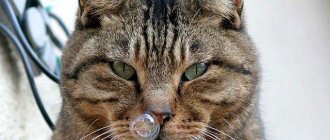Conjunctivitis in cats is one of the most common eye pathologies. Minor tearing may indicate a viral infection, the development of food intolerance, or a foreign object entering the eye. Whatever it is, drug treatment is mandatory, otherwise the animal may go blind.
Only a specialist can make the correct diagnosis and prescribe the necessary treatment. But the cat owner must also know about the causes, symptoms and preventive measures in order to provide timely help to the animal.
Forms of conjunctivitis
There are several types and forms of the disease:
- primary conjunctivitis (with direct infection in the eye);
- secondary conjunctivitis (develops against the background of another disease, as a complication, as a result of the transfer of inflammation from nearby tissues, for example, due to mechanical injuries);
- acute conjunctivitis (an intense process with activation of the bacterial flora and pronounced clinical signs);
- chronic conjunctivitis (long-term and sluggish process).
Acute catarrhal conjunctivitis
This is conjunctivitis with pronounced redness of the mucous membrane, swelling and inversion of the cat's eyelid. Due to increased lacrimation, “wet paths” are formed on the animal’s face. The cat is in pain, often washes itself and rubs the eye area with its paws. The process may affect one or both eyes.
This form of conjunctivitis is considered the most harmless and can be easily treated with anti-inflammatory drops.
Purulent conjunctivitis
It is characterized by abundant formation of cloudy greenish pus and crusts in the corners of the eyes. If left untreated, the process intensifies, an unpleasant odor appears, the cat's eyelids swell and stick together, and the hair around the eyelids falls out.
With purulent conjunctivitis, cats often experience weakness, increased body temperature and photophobia. The disease requires treatment with antibacterial drugs.
Follicular conjunctivitis
The most severe form of feline conjunctivitis. With it, inflammation of the lymphatic follicles that are located in the conjunctiva, as well as protrusion of the third eyelid, is observed.
The pathological process develops slowly, minor discharge appears. When examining the mucous membrane of the eyes, clusters of dark red follicles are visualized on the inner surface of the eyelid.
This is a dangerous type of inflammation that requires serious therapy under the supervision of a veterinarian. Sometimes surgical intervention is indicated - removal of the third eyelid.
Parenchymal conjunctivitis
This disease is characterized by severe swelling of the eyelids, copious discharge of serous-mucous or purulent exudate, and fear of light. The conjunctiva becomes very red and protrudes beyond the palpebral fissure.
Purulent discharges gradually dry out, and when they are removed, bleeding may occur. If the disease is not treated in time, the kitten may lose its vision.
Allergic conjunctivitis
When allergic manifestations occur in a cat, so-called “tear tracks” form on the fur under the eyes. Due to constant lacrimation, the mucous membrane becomes irritated, it becomes red and inflamed.
The pet's face takes on an unkempt appearance, the cat washes itself frequently, and the “tear tracks” acquire a reddish tint over time. This picture can often be observed in short-faced cat breeds of white colors (Persian, exotic, Scottish).
Types of disease
Depending on the nature of the fluid separated from the eye, the following are distinguished:
- Catarrhal - the owner notices that tears and clear mucus are flowing from the eye. Very often, such conjunctivitis can later turn into the following type.
- Purulent conjunctivitis - pus discharges from the eye. It can be white, yellow, greenish, more or less thick. Often the eyelids are glued together with discharge, and there is a pronounced “path” to the nose. The fur around the eye may be sparse; the cat may scratch its face vigorously, trying to get rid of the thick pus covering the eye, and tear out pieces of fur.
Depending on the characteristics of the process, the following are distinguished:
- Chronic - usually this is a long-term process, the severity of symptoms may vary, the duration is measured in months or years, it can be lifelong;
- Subacute - several weeks or days, often accompanied by respiratory infections;
- Acute - several hours, typical for injuries.
Causes of conjunctivitis in cats
The reasons are very varied:
- mechanical injuries and wounds, ingress of dirt;
- household chemicals with a strong odor (paints, aerosols, deodorants);
- infectious diseases of cats (viral rhinotracheitis, calicivirus, chlamydia);
- penetration of parasitic worms into the eyeball;
- incorrectly selected dry food (if food intolerance to certain foods is present);
- Trichiasis of the eyelids is the pathological growth of eyelashes inside the cat's eye.
Is it possible to get infected?
You can get conjunctivitis from a cat, but only if it is viral or bacterial in nature. The main method of transmission is contact infection ; airborne transmission is also possible for viruses.
However, it is transmitted to humans quite rarely, since people and cats are usually affected by different strains of the pathogen, and this requires close contact, which does not happen often.
Symptoms
Common symptoms of conjunctivitis in cats are:
- photophobia (in bright daylight, the animal hides in the shadows because it experiences pain when moving the eyes);
- swelling and redness of the mucous membrane;
- increased licking of the front paws and washing the face;
- decreased appetite.
With intensive formation of exudate, the eyelids stick together, this is especially noticeable with viral conjunctivitis in cats.
Important! In almost 60% of cases of conjunctivitis infection, symptoms appear in only one eye, and after a few days the second eye is involved in the process.
In kittens with unopened eyes (up to 10 days of age), conjunctivitis is also not uncommon. Infection mainly occurs from the mother and is a sign of infectious rhinotracheitis. It manifests itself as swelling of the eyelids, purulent discharge with the formation of crusts.
What are the signs that should promptly consult a doctor?
If your cat's behavior changes noticeably, excessive licking of the face and paws is observed, and appetite decreases, you should consult a veterinarian. You also need to monitor your pet’s temperature twice a day.
If it is impossible to visit a veterinarian in the next 24 hours, it is recommended to provide first aid to the animal. You need to wipe the eye area with an antiseptic (a solution of Furacilin or diluted Chlorhexidine).
Self-selection of eye drops (especially from a human first aid kit) is undesirable, as it can only aggravate the process.
Main reasons
There are many reasons for the development of eye inflammation:
- Mechanical causes are eye injuries, the presence of foreign bodies.
- Chemical causes are irritation resulting from contact with gases, vapors, and acids.
- Infectious causes.
- Transition of the inflammatory process from one area to another.
- Allergens. A similar illness can arise from plant pollen or the host’s new perfume. In this case, it is necessary to observe what factor caused the irritation and eliminate it from everyday life.
Unfortunately, many owners, having discovered conjunctivitis in a kitten, are in no hurry to treat it at the veterinarian, but this ailment can be a harbinger of a serious infectious disease, and this cannot be done without consulting a veterinarian.
Diagnosis of conjunctivitis in cats
The algorithm for diagnosing feline conjunctivitis includes the following steps:
- Examination of the animal, interviewing the owner about any changes in the cat’s behavior.
- Taking blood for general and clinical analysis (this is necessary to determine the degree of the inflammatory process).
- Taking swabs from the conjunctiva to conduct a laboratory examination using the PCR (polymerase chain reaction) method. This will help determine the nature of the origin of the infection (bacterial, viral or allergic).
- If necessary, it may be necessary to culture eye secretions for microflora to determine sensitivity to antibiotics, which will subsequently simplify the choice of medication.
- In clinics with modern equipment, they may offer to examine the cat using biomicroscopy (using a special optical device - a slit lamp). The procedure allows you to examine the eyelids, conjunctiva, cornea, anterior chamber, iris and partially the lens in 5-7 minutes.
Treatment
Unfortunately, any chronic disease (not excluding conjunctivitis) is difficult to treat. This is especially true for inflammation of a bacterial nature. In advanced cases of the disease, microorganisms are “hardened” and their sensitivity to drugs decreases. It becomes difficult to destroy them.
So treatment involves the following activities:
- The eyes of a sick pet should be washed regularly with sterile saline solution (warmed to 37° Celsius).
- At least three times a day, 1% tetracycline ointment is applied to the conjunctival cavity.
But before starting to use any antimicrobial agents, it is strongly recommended to take samples of pathological material and grow colonies of the pathogen on nutrient media (and also simply examine the material under a microscope). This way you can find out which microbe caused the inflammation, and also choose the most effective medicine against it.
How to treat conjunctivitis in cats
To alleviate the condition, you need to provide the animal with rest in a room with dim light, and also rinse the eyes with an antiseptic solution.
Therapy of acute catarrhal conjunctivitis involves the use of ophthalmic drops with antibacterial components. Treatment is carried out 2-4 times a day, for a course of 5-7 days.
For eye inflammation with purulent discharge, drops and ointments with broad-spectrum antibiotics are prescribed. If your cat has severe swelling and pain, you can drop 2-3 drops of a 2% Novocaine solution under the lower eyelid, this will alleviate the condition.
The allergic form of conjunctivitis does not always require drug treatment. If the cause of the disease is eliminated in a timely manner (change food, do not use aerosols with a pungent odor, etc.), the cat will recover on its own. Otherwise, the use of antihistamines intended for humans (for example, Suprastin, Zyrtec, Loratadine) is indicated. The dosage and course of treatment should be determined by a veterinarian.
In the treatment of viral conjunctivitis in cats, a wide range of drugs is used: hyperimmune serum Vitafel, Globfel; broad-spectrum antibiotics Ceftriaxone, Amoxicillin or Enrofloxacin; vitamins and eye drops with Levomycetin.
Follicular conjunctivitis of cats is treated exclusively in a clinical setting, since it will require cleaning the third eyelid with anesthesia of the eyes (retrobulbar block involves the introduction of Novocaine into the space behind the eyeball).
Anti-inflammatory cat drops are prescribed by a doctor, taking into account the severity of the disease.
Important! In the treatment of kittens and pregnant cats, the use of antibiotics such as Tetracycline and Ciprovet is contraindicated.
Eye wash
This is a mandatory procedure for successful treatment of conjunctivitis at home; it is carried out 2-3 times a day.
Technique:
- Secure the cat - swaddle it in thick fabric or place it in a special bag-retainer. It is advisable to trim your pet's nails, as during the treatment he may resist and scratch.
- Soak a gauze pad or cotton pad in the washing solution:
- warm decoction of chamomile or calendula (prepare it yourself or buy it ready-made at a pet store);
- Furacilin (1 tablet per 100 ml of water or saline);
- boric acid (1/2 teaspoon of acid per 1 glass of warm water);
- Chlorhexidine (pre-dilute the pharmaceutical 0.05% drug with water in a ratio of 1:2).
- Soften dried crusts and remove discharge from the eyes. The correct way to wash a cat is in the direction from the outer corner of the eyelid inwards towards the bridge of the nose.
After the procedure, you need to reward the cat with a treat and praise.
Application of drops
Ophthalmic drops for the treatment of conjunctivitis in cats are now widely available in veterinary pharmacies and pet stores. The preparations contain an antibiotic (in the optimal dosage for a small animal) or other anti-inflammatory components.
The drops are universal for cats, dogs, rodents, and rabbits.
Review of veterinary drugs in the form of eye drops:
| Name | Active composition | Treatment regimen | Contraindications |
| Bars (AgroVetZashchita) | Levomycetin 0.25%, Furacilin 0.02% | 1 drop 3-4 times a day, course 1-2 weeks | If there is an individual intolerance to the components of the drug |
| Iris (AgroVetZashchita | Gentamicin 4% | 1 drop in each eye 4 times a day, course 1-1.5 weeks | If there is an individual intolerance to the components of the drug |
| Anandin (Meditere) | Glucoaminopropylacridone 2% | 2 drops 2 times a day, course 5 days | If there is an individual intolerance to the components of the drug |
| Tsiprovet (AgroVetZashchita) | Ciprofloxacin 0.45% | 1 drop 3-4 times a day, course 1-2 weeks | Do not use on kittens and puppies under 7 days of age |
| Desacid (Beekeeper) | Gentamicin, Royal Jelly, Succinic Acid | 2 drops in each eye 3 times a day for 7 days | If there is an individual intolerance to the components of the drug |
| Lachrikan (Top Vet) | Polysept 0.02%, anesthesin 0.002%, menthol 0.005% | 1-2 drops 2-3 times a day, course 1-1.5 weeks | Not declared |
| Ophthalmosan (ApiSan) | Chlorhexidine and Succinic acid | 2 drops 1-3 times a day, course 1 week | If there is increased intolerance to the components of the drug |
| Decta-2 (ApiSan) | Gentamicin, Dexamethasone | 2 drops 2-3 times a day, course 5-10 days | Individual intolerance, ulcers and erosions of the cornea, glaucoma |
Important! Albucid is a human drug, the use of which is unacceptable for cats. This remedy causes a painful burning sensation in the kitten's eyes due to hypersensitivity, more developed than in humans. Therefore, it is impossible to cure conjunctivitis in cats with this drug; the process will only get worse.
In veterinary ophthalmology, there are often cases of prescribing human medications that are considered conditionally suitable for the treatment of eyes in cats. Such drops are:
- Levomycetin (composition similar to Bars veterinary drops);
- Tsiprolet (analogous to Tsiprovet);
- Floxal (no veterinary analogues);
- Tobrex (no veterinary analogues).
These medications can be used if prescribed by a veterinarian.
How to properly drop the drug into a cat’s eyes for conjunctivitis:
- Secure the pet (wrap it in a towel or thick cloth).
- Using your index finger and thumb, open the cat's eyelids.
- Place 1-2 drops into the outer corner of the eye.
- Lightly massage your eyelids for better distribution of the product.
Use of ointments
Eye ointments are considered more effective in ophthalmology because they remain longer in the conjunctival cavity and have a prolonged effect. However, in veterinary practice in the Russian Federation, only tetracycline ointment in 1% concentration is used to treat conjunctivitis in cats (as of 2022).
Pet stores may offer the drug Optimmune, but according to the manufacturer’s instructions, the ointment is intended for dogs, so its prescription must be confirmed by a veterinarian.
How to apply ointment to a cat:
- Lay the animal down and secure its paws.
- Carefully open the eye and place the ointment behind the eyelid.
- Close your eyelids and massage lightly.
- Treat the second eye.
The procedure should be carried out carefully so as not to press your fingers on the eyeball.
The use of tetracycline ointment for feline conjunctivitis involves its use 2-3 times a day for 5-7 days.
Systemic treatment of conjunctivitis
In case of serious infection (purulent, phlegmonous, follicular conjunctivitis) or when a viral agent is diagnosed, veterinarians include injectable antibiotics and tablets in the treatment regimen.
The purpose of a particular drug is determined by the physiological state of the animal, the development of concomitant diseases and the severity of the disease.
Mostly medications are prescribed with the following active ingredients: Ciprofloxacin (Ciprovet 5%), Enrofloxacin (Baytril 2.5%), Amoxicillin (Betamox), Azithromycin. In extreme cases, Gentamicin and Tetracycline (outdated drugs with side effects) are prescribed.
Systemic treatment is selected individually for each animal after an extensive examination. Self-medication in this case is unacceptable.
Sources
There are many factors that can provoke the development of an inflammatory process in the conjunctiva in a cat. Let's look at the main reasons.
Viruses, germs and fungi
One of the most common causes of conjunctivitis. You can easily judge the health of an animal by its eyes. Almost any viral or bacterial disease leads to the development of inflammation of the conjunctiva. In case of fungal diseases, the pathogen settles on the mucous membrane itself and affects it. It is much more difficult to treat a disease caused by fungi.
Allergic reaction
The formation of allergic conjunctivitis is also observed quite often. In the situation with pets, as with people, similar symptoms are observed with allergies.
An allergic reaction manifests itself in the form of a runny nose, sneezing, itching, sore throat or ears, as well as excessive lacrimation. There is redness, swelling and itching of the conjunctiva. You can get rid of this form of the disease only after eliminating the signs of an allergic reaction in the cat.
In this case, you will need to determine the irritant and completely get rid of it, and the animal will need treatment.
Mechanical damage
Even the slightest damage can cause infection. To prevent this phenomenon, the glands produce tears in large quantities. Thanks to this, the “concentration” of microbes decreases, but it will not be possible to completely get rid of them in this way. Over time, some pathogenic bacteria can reach the wound.
As a result, the cat develops inflammation of the conjunctiva.
Any injury to the eye, be it a wound on the eyelid or on the eyeball itself, is dangerous. There is a risk of vision loss in both the first and second cases.
Chemicals
In such a situation, the development of catarrhal conjunctivitis in a cat is observed due to the contact of chemical vapors with the mucous membranes. A burn to the conjunctiva is more dangerous because it can cause the animal to go blind if it does not react immediately.
Thanks to its natural curiosity, the cat, noticing that some container with chemicals is open, will begin to sniff it. If it comes to researching powdered chemistry, the possibility of “getting” inflammation of the conjunctiva increases.
In this case, the causative agent of the disease will be small particles of the product, acting as a foreign body in the eyes, which leads to damage to the mucous membrane.
Irradiation
Both X-ray and radioactive radiation, as well as ultraviolet radiation, can harm the eyes of an animal. Cats should be protected from any kind.
Owners of terrariums that use ultraviolet lamps should take into account that such irradiation is harmful to both animals and humans.
In addition, girls also need to be careful, often purchasing special ultraviolet devices to polymerize gel polish at home. When this machine operates, it emits violet light that attracts your pet.
If you watch the light for a long time, problems with the conjunctiva will appear very quickly.
Be sure to read the article about other eye diseases in cats so as not to confuse conjunctivitis with anything.
Forecast
Feline conjunctivitis is a serious condition and can be caused by a virus or other infection. Without medical intervention, the disease becomes chronic and can cause pathological changes in the structure of the eye and lead to blindness. Therefore, it is very important to provide timely assistance to a sick animal and maintain visual acuity. The earlier treatment is started, the greater the chance of a favorable prognosis.
Rinse the cat's eyes: useful tips
If a kitten's eye is swollen and festering, rinsing should be done carefully, having first taken care of your safety. During the procedure, the pet will be nervous and struggle, so it should be well secured (or use the help of a second person who will hold the animal). The best option is to swaddle the cat with a towel or diaper so that only the head remains outside. Please also adhere to the following recommendations .
- Rinse each eye with solution from a separate container.
- Twist the cotton wool into a tight rope, dip it in a warm broth (medicinal solution), and squeeze it onto the animal’s festering eye.
- When the pet's eyes are completely cleared of purulent discharge, apply tetracycline ointment (1%) under the cat's eyelid. To do this, pull back the animal’s lower eyelid and, using a special spatula, place the composition on its inner surface. Then close your cat's eye completely and massage it lightly. This will help the product to be distributed evenly. To further enhance the effect of using the ointment, preheat the tube with it in your hands. But if the cat is very nervous, then you should not apply the ointment under the eyelid (this can lead to injury to the organ of vision).
© shutterstock
Prevention of conjunctivitis
To ensure that your cat’s gaze is always clear and his vision sharp, you must follow a few simple rules:
- Vaccinate your pet annually against viral diseases and chlamydia;
- sanitize the eyes and ears every week using cleansing lotions for animals or herbal decoctions;
- treat your cat monthly for external parasites;
- do not allow contact with odorous substances and do not spray aerosols near the animal;
- isolate from stray cats.
A cat's eyes are a very vulnerable organ, prone to frequent inflammation. Therefore, a caring owner must understand that success in the treatment of conjunctivitis depends on a competent sequence of actions and strict adherence to the veterinarian’s instructions.











